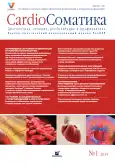Comprehensive medical rehabilitation program after percutaneous coronary intervention for acute myocardial infarction in patients with coronary heart disease and arterial hypertension: efficacy, safety, and the results of remote monitoring
- Authors: Bubnova M.G1, Aronov D.M1, Krasnitskiy V.B1, Novikova N.K1, Matveeva I.F1, Ioseliani D.G2
-
Affiliations:
- State Research Center for Preventive Medicine, Ministry of Health of Russian Federation
- ГБУЗ Научно-практический центр интервенционной кардиоангиологии Департамента здравоохранения
- Issue: Vol 6, No 1 (2015)
- Pages: 6-11
- Section: Articles
- URL: https://journals.rcsi.science/2221-7185/article/view/45101
- DOI: https://doi.org/10.26442/CS45101
- ID: 45101
Cite item
Full Text
Abstract
Full Text
##article.viewOnOriginalSite##About the authors
M. G Bubnova
State Research Center for Preventive Medicine, Ministry of Health of Russian Federation
Email: mbubnova@gnicpm.ru
д-р мед. наук, проф., рук. отд. реабилитации и вторичной профилактики сочетанной патологии с лаб. профилактики атеросклероза и тромбоза ФГБУ ГНИЦ ПМ 101000, Russian Federation, Moscow, Petroverigsky per., d. 10, p. 3
D. M Aronov
State Research Center for Preventive Medicine, Ministry of Health of Russian Federationд-р мед. наук, проф., засл. деят. науки РФ, рук. лаб. кардиологической реабилитации ФГБУ ГНИЦ ПМ 101000, Russian Federation, Moscow, Petroverigsky per., d. 10, p. 3
V. B Krasnitskiy
State Research Center for Preventive Medicine, Ministry of Health of Russian Federationканд. мед. наук, вед. науч. сотр. лаб. кардиологической реабилитации отд. реа- билитации и вторичной профилактики сочетанной патологии ФГБУ ГНИЦ ПМ 101000, Russian Federation, Moscow, Petroverigsky per., d. 10, p. 3
N. K Novikova
State Research Center for Preventive Medicine, Ministry of Health of Russian Federationканд. мед. наук, ст. науч. сотр. лаб. кардиологической реабилитации отд. реа- билитации и вторичной профилактики сочетанной патологии ФГБУ ГНИЦ ПМ 101000, Russian Federation, Moscow, Petroverigsky per., d. 10, p. 3
I. F Matveeva
State Research Center for Preventive Medicine, Ministry of Health of Russian Federationмл. науч. сотр. лаб. профилактики атеросклероза и тромбоза отд. реабилитации и вто- ричной профилактики сочетанной патологии ФГБУ ГНИЦ ПМ 101000, Russian Federation, Moscow, Petroverigsky per., d. 10, p. 3
D. G Ioseliani
ГБУЗ Научно-практический центр интервенционной кардиоангиологии Департамента здравоохраненияд-р мед. наук, проф., дир. научно-производственного Центра интервенционной кардиоангиологии Департамента здравоохранения г. Москвы 101000, Russian Federation, Moscow, Sverchkov per., d. 5
References
- Murray C.J, Lopez A.D, Jamison D.T. The global burden of disease in 1990: summary results, sensitivity analysis and future directions. Bull World Health Organ 1994; 72: 495-509.
- Levi F et al. Trends in mortality from cardiovascular and cerebrovascular diseases in Europe and other areas of the world. Heart 2002; 88: 119-24.
- Бубнова М.Г., Аронов Д.М., Оганов Р.Г. и др. Клиническая характеристика и общие подходы к лечению пациентов со стабильной стенокардией в реальной практике. Российское исследование ПЕРСПЕКТИВА. Ч. I. Кардиоваск. тер. и проф. 2010; 6: 47-56
- Аронов Д.М., Бубнова М.Г., Красницкий В.Б. и др. Современные методы реабилитации больных КБС на постстационарном (диспансерно - поликлиническом) этапе. Пособие для врачей. М., 2004.
- Аронов Д.М., Зайцев В.П. Методика оценки качества жизни больных с сердечно - сосудистыми заболеваниями. Кардиология. 2002; 5: 92-5.
- Красницкий В.Б., Аронов Д.М., Джанхотов С.О. Изучение физической активности у больных ИБС с помощью специализированного Опросника двигательной активности «ОДА- 23+». Кардиоваск. тер. и проф. 2011; 8: 90-7.
Supplementary files







